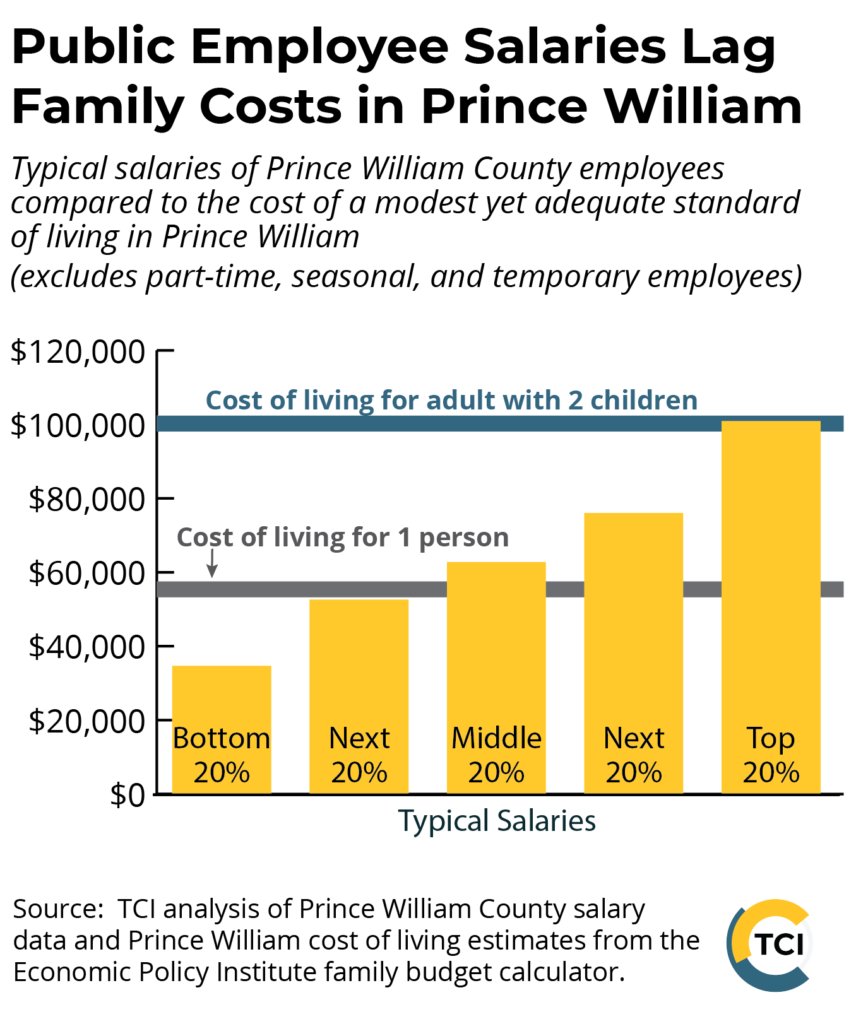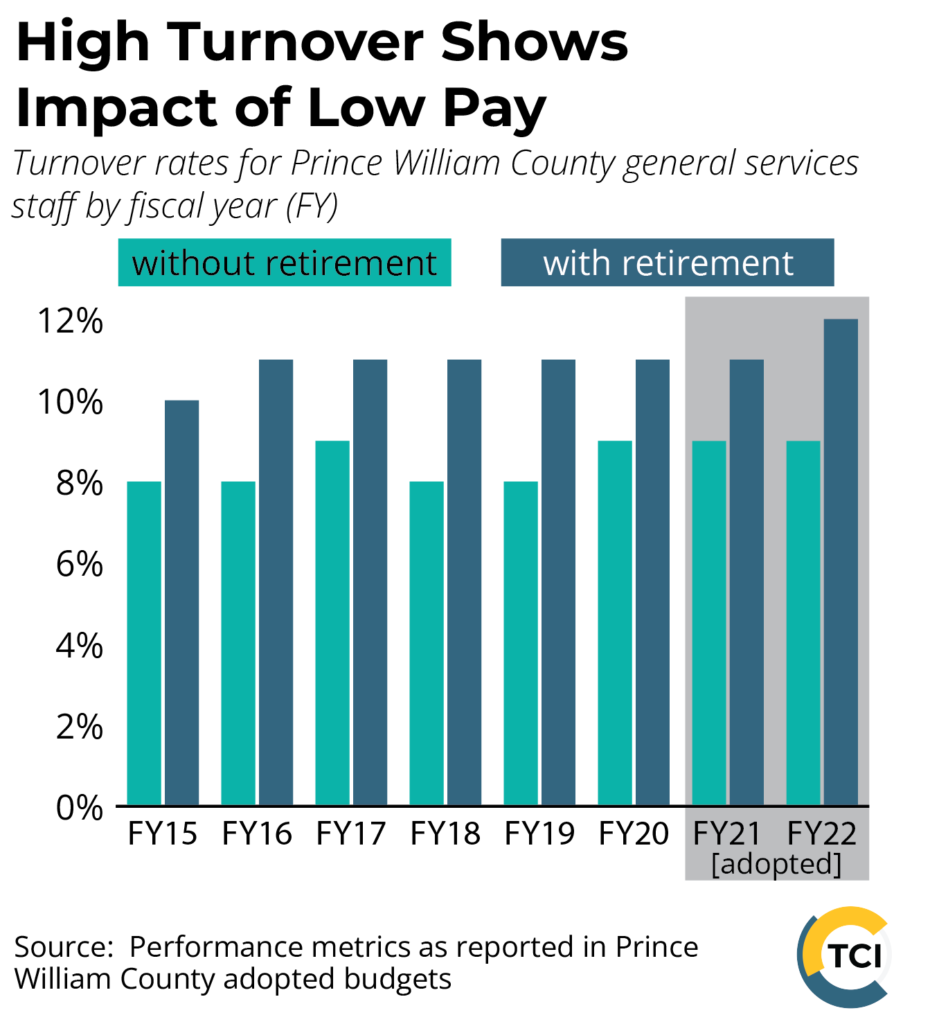April 5, 2022
Coming Together in Prince William: Collective Bargaining Advances Equity and Strengthens Families
Prince William County is one of the fastest-growing and most diverse communities in the Commonwealth of Virginia. It allows its residents to access city-like amenities and culture while remaining close to natural wonders like the Potomac River and the Blue Ridge Mountains. A key member of the outer Northern Virginia region, Prince William County is grappling with the opportunities, changes, and challenges caused by its impressive population growth over the last decade.
Prince William County’s public employees play a critical role in advancing the county’s priorities. They must receive fair wages and be empowered in their roles in order to deliver high-quality public services to a rapidly changing community. The ability to bargain collectively will ensure public service employees more equitable working conditions, improve worker retention, and improve public services for all workers and residents of Prince William County.
County employees in Prince William are currently underpaid

- Many Prince William employees cannot afford to live in the community they serve. A review of full-time county employee salaries shows that over 1 in 3 of all county employees could not afford to support themselves on their salary in Prince William County. And 9 out of 10 could not attain an adequate standard of living on what they are paid if they have two children.1
- Looking just at general services county workers, over 4 in 10 who work full-time and year-round do not make enough to support themselves, and 9 out of 10 do not make enough to support a family.
- A majority of general services employees in Prince William are women, and people of color are more likely to be in lower-paid general services positions than in other county government positions.2
- Local government public employees in Virginia are typically paid 29.9% less than their private-sector peers with similar levels of education, age, and hours worked, one of the largest pay penalties in the country. Although data is limited, it appears that the penalty is even larger in Northern Virginia, with local government employees being paid 33.4% less than their private-sector peers.3
- Pension and health care benefits do not make up for these pay penalties. Employee benefits for local public employees in Virginia are less generous than in other parts of the country, and many private-sector employees, particularly full-time employees of large companies, receive generous benefits. For Virginia as a whole, the estimated total compensation penalty for local employees compared to their private-sector peers is 28.0%, close to the original pay penalty of 29.9%.4
Turnover rates for Prince William’s workforce are significant and costly

- The turnover rate for Prince William County employees has been high for nearly a decade. Data analysis from the county budgets from July 1, 2014 to June 30, 2022 (fiscal years 2015 to 2022) show an average turnover without retirement rate of 8.5% and an average turnover with retirement rate of 11% for county employees.
- The high turnover rate poses serious costs to the county. A review of 30 case studies in 11 research papers found that turnover costs employers between 16% and 21% of an employee’s annual salary.5
Indeed, it is costly to replace workers because of the productivity losses when someone leaves a job, the costs of hiring and training a new employee, and the slower productivity until the new employee gets up to speed in their new job. Our analysis reviews 30 case studies in 11 research papers published between 1992 and 2007 that provide estimates of the cost of turnover, finding that businesses spend about one-fifth of an employee’s annual salary to replace that worker.
Heather Boushey and Sarah Jane Glynn, “There Are Significant Business Costs to Replacing Employees, Center for American Progress, 2012
Collective bargaining reduces unfair pay inequities
Local government employees in Virginia are typically paid 29.9% less than their private-sector counterparts with similar education, and benefits do little to make up for these pay penalties. But states where public employees are allowed some sort of permission to collectively bargain have smaller pay penalties. Furthermore, unions are particularly important for raising pay for those who have historically been marginalized and underpaid compared to their levels of experience and education.
For public employees, one of the benefits of unions is increased pay to levels that are closer to that which could be obtained in the private sector. In states with a policy like Virginia’s new law that allows – but does not require – localities to permit employees to collectively bargain, the average pay gap for local employees compared to their private-sector peers is 16.6%. The pay gap in states where collective bargaining rights for local employees are protected by the state is 10.5%.6 Overall, public-sector collective bargaining tends to boost pay by 5% to 8%.7
Additionally, the fair and clear standards provided by unionization particularly support Black and Latinx workers. In fact, anti-union laws throughout the south were passed using explicit appeals to racist ideas. Past discrimination and ongoing barriers mean Black workers, Latinx workers, and women of all races are still typically paid less than white men with the same level of education and experience in both public- and private-sector employment.
Collective bargaining helps to fix this where allowed. In states where public employers are required to bargain, Black and Hispanic workers earn more in local government than in the private sector, where they face large racial pay gaps. In states where collective bargaining is permitted but not required, Black and Hispanic workers are paid about the same in both sectors. Where public-sector collective bargaining is banned, Black and Hispanic workers are paid even less in local government jobs than in the private sector, despite the large racial pay penalties they face in the private sector. And, as noted above, women are the majority of county general services employees. Thus, collective bargaining can help address the broader societal problem of women and people of color being paid less than their peers with similar levels of educational attainment and experience, while also particularly boosting wages for Black and Hispanic workers, helping attract more to local public service jobs.
Having a union provides a voice in the workplace and has a positive impact on democratic participation
The positive impact of unions is not limited to pay and benefits. Collective bargaining provides a way for represented workers to formally express their ideas for improving their workflow and workplaces. This can improve communication and a sense of belonging. Quantitative comparison of union members and non-union members finds that having the experience of collective bargaining and union representation in the workplace even makes people — particularly younger people and those with less formal education — more likely to participate in other systems of democratic governance such as voting.8

“We advocate hard for the well-being of our clients, because they are far more likely to not receive treatment because the medical community doesn’t view them basically as human. We’ve been fighting that fight even before the pandemic; the pandemic just exacerbated it. We’re just managing and trying to keep it from exploding. People are getting burnt out and people need a break. This is why we need collective bargaining and a union. Collective bargaining will help us to address high turnover and low staff levels. We need a voice on the job so we can speak out and demand the changes and resources we need to keep doing the work safely. When we are asked to take an extra five cases, we should have a say in how to best handle the heavy workload. Listen to our suggestions instead of constantly saying ‘Oh no, we can’t do that.’ Otherwise, people will keep leaving and the problems will get much worse.”
KERENSA GREEN-SUMERS | CLINICAL SERVICES CASEWORKER, DEVELOPMENTAL/INTELLECTUAL DISABILITY SERVICES, COMMUNITY SERVICE BOARDCollective bargaining is critical to ensuring equity as Prince William County continues to grow
As one of the fastest-growing and most diverse counties in the commonwealth, Prince William County faces just as many opportunities for growth as it does challenges in the coming decades. The county’s priorities and goals for its communities are impossible to achieve without the contributions of public employees. Far too many of these public service employees are underpaid and lack a democratic voice in their workplace. This dynamic only serves to exacerbate already existing unfair pay inequities. Moreover, the turnover rates caused by this same dynamic remain high and costly.
Collective bargaining has been shown to increase wages, improve working conditions, and support worker retention. When workers are empowered in this way, public services and democratic participation also stand to greatly benefit. Prince William County public employees must be afforded the ability to bargain collectively so that the county can ensure a prosperous and equitable future for all.
Endnotes
- TCI analysis of 2021 salary data and EPI family budget calculator for a family of one adult and two children. Pay and salary data includes both merit and non-merit employees and includes court employees and employees of constitutional officers. Results are similar when excluding court employees and employees of constitutional officers. Part-time and seasonal employees are excluded from this analysis. EPI analysis from 2022 shows that a single person in Prince William County would need an annual income of $55,362 to pay for housing, transportation, healthcare premiums and out-of-pocket costs, taxes, and other necessities. For a parent with two children, that amount is $100,233. Budget calculator can be found at https://www.epi.org/resources/budget/
- PWC data on employee job function and demographic makeup can be found at: https://www.pwcva.gov/assets/2021-06/Final%20PWC%20Workforce%20Demographics%205.17.2021_0.pdf.
PWC pay bands can be accessed at: https://www.pwcva.gov/department/human-resources/classification-compensation - Morrissey, M., “Unions can reduce the public-sector pay gap: Collective bargaining rights and local government workers,” Economic Policy Institute, Jun 2021.
- Ibid.
- Boushey, H., and Glynn, S., “There Are Significant Business Costs to Replacing Employees,” Center for American Progress, Nov 2012
- Morrissey, M., Economic Policy Institute, Jun 2021.
- Bryson, A., Gomez, R., Kretschmer, T., and Willman, P., “Workplace voice and civic engagement: what theory and data tell us about unions and their relationship to the democratic process,” Osgoode Hall Law Journal, 2013
- Ibid.
